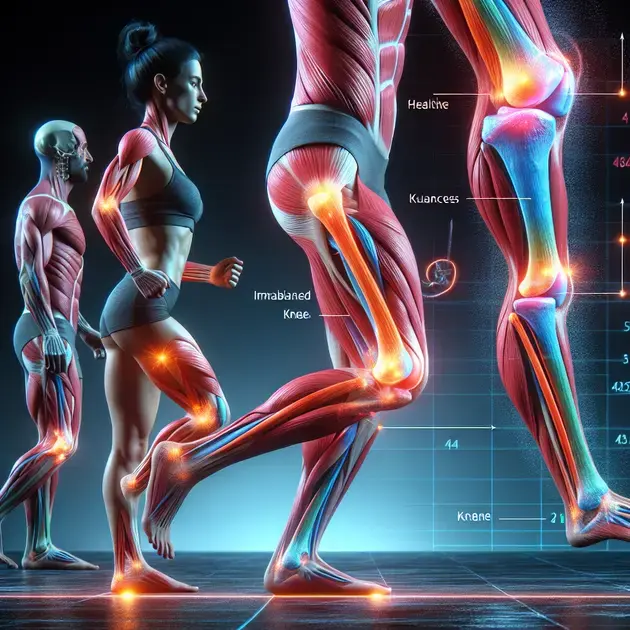Understanding the Root Cause of Knee Pain is crucial for finding the right treatment and achieving long-term relief. With the increasing prevalence of knee pain among individuals of all ages, it’s essential to delve deeper into the underlying factors contributing to this issue.
Recent studies have shown that knee pain is often a result of various factors, including muscle imbalances, overuse injuries, or underlying conditions such as arthritis. By understanding the root cause of knee pain, individuals can take proactive steps to address the issue and prevent future complications.

Understanding the Importance of Identifying Knee Pain Triggers
Knee pain can be a common issue that affects people of all ages, and identifying the triggers behind this discomfort is crucial for effective management. One important step in understanding knee pain triggers is keeping a detailed journal of activities and symptoms. By noting down when the pain occurs, the level of intensity, and any specific movements that exacerbate it, individuals can start to identify patterns.
Additionally, utilizing wearable technology such as fitness trackers or health apps can help track daily activities and provide insights into potential triggers. Apps like MyFitnessPal or Fitbit, for example, allow users to monitor their exercise routines, calorie intake, and overall fitness levels, which can be linked to knee pain triggers.
Consulting with a healthcare professional or a physiotherapist is also essential in identifying knee pain triggers. These professionals can conduct physical exams, analyze gait patterns, and recommend specific tests or imaging studies to pinpoint the root cause of the pain. By seeking expert guidance, individuals can gain a clearer understanding of the factors contributing to their knee discomfort.
Furthermore, exploring online resources from reputable medical websites such as WebMD or Mayo Clinic can provide valuable information on common knee pain triggers. These platforms offer articles, videos, and forums where individuals can learn about potential causes such as overuse injuries, arthritis, or muscle imbalances that lead to knee pain.
Incorporating self-care practices like gentle stretching, icing, or using supportive braces can also aid in identifying knee pain triggers. By observing how the pain responds to these interventions, individuals can gather insights into the specific activities or movements that worsen or alleviate their knee discomfort.
Exploring the Connection Between Muscle Imbalances and Knee Pain
Muscle imbalances can play a significant role in the development of knee pain, highlighting the importance of addressing these asymmetries for long-term joint health. To explore the connection between muscle imbalances and knee pain, individuals can start by assessing their muscle strength and flexibility through simple at-home tests.
Apps like PhysiApp or PT-Helper provide guided exercises and assessments to help users identify muscle imbalances that may be contributing to knee pain. These apps offer visual demonstrations and personalized workout plans tailored to specific muscle groups, allowing individuals to target areas of weakness or tightness.
Engaging in strength training exercises that focus on building the quadriceps, hamstrings, and calf muscles can help correct muscle imbalances and reduce the strain on the knee joint. Fitness apps like Nike Training Club or StrongLifts 5×5 offer structured workout routines designed to improve overall muscle balance and stability, which are essential for preventing knee pain.
Seeking guidance from a certified personal trainer or a physical therapist can provide additional insight into addressing muscle imbalances related to knee pain. These professionals can create customized exercise programs, offer hands-on guidance for proper form, and monitor progress to ensure a balanced muscle development.
Exploring the link between posture and muscle imbalances is also vital in understanding knee pain triggers. Utilizing posture-correcting apps like UPRIGHT GO or PostureScreen Mobile can help individuals assess their postural alignment and make necessary adjustments to alleviate strain on the knees caused by poor posture habits.
Taking Action: Addressing the Underlying Factors of Knee Pain
When it comes to addressing knee pain, taking proactive steps to target the underlying factors contributing to discomfort is key for long-term relief and prevention. One effective action individuals can take is participating in low-impact exercises that promote joint mobility and strength without exacerbating knee pain.
Apps like Yoga for Beginners or Peloton Digital offer yoga and low-impact workout classes that focus on improving flexibility, balance, and core strength, which are beneficial for supporting knee health. By incorporating these exercises into their routine, individuals can address underlying factors such as flexibility limitations or weak stabilizing muscles.
Implementing lifestyle changes such as maintaining a healthy weight and incorporating anti-inflammatory foods into the diet can also help address underlying factors of knee pain. Apps like MyPlate Calorie Counter or MyFitnessPal can assist in tracking dietary habits and monitoring nutrient intake to support joint health and reduce inflammation.
Utilizing mindfulness and stress-reduction techniques through meditation apps like Headspace or Calm can aid in managing pain perception and promoting relaxation, which are essential in addressing the emotional aspect of knee discomfort. By incorporating these practices, individuals can enhance their overall well-being and reduce the impact of stress on their joints.
Collaborating with a multidisciplinary healthcare team that may include orthopedic specialists, physical therapists, and nutritionists can provide a comprehensive approach to addressing the underlying factors of knee pain. These professionals can offer a personalized treatment plan, recommend targeted interventions, and support individuals in achieving long-lasting relief from knee discomfort.

**Understanding the Importance of Diagnosing Knee Pain Early**
Signs of Knee Pain
Recognizing the early signs of knee pain is crucial for timely diagnosis and treatment. Common symptoms may include swelling, stiffness, redness, or warmth in the affected area. Pain or discomfort during movement, clicking or popping sounds, or difficulty bearing weight on the knee are also indicators that should not be ignored.
Misconceptions About Knee Pain
It is important to address misconceptions surrounding knee pain, such as attributing it solely to aging or overexertion. While these factors can contribute to knee pain, underlying conditions like osteoarthritis, ligament injuries, or even referred pain from other sources should be considered. Early diagnosis can help differentiate between these causes and guide appropriate treatment.
Importance of Early Intervention
Early diagnosis of knee pain allows for prompt intervention to prevent progression of the condition. Delayed diagnosis can lead to worsening symptoms, decreased mobility, and potential complications. Seeking medical evaluation at the onset of knee pain can help in implementing effective treatment strategies and improving long-term outcomes.
Diagnostic Techniques
Various diagnostic techniques, such as imaging tests like X-rays, MRIs, or CT scans, along with physical examinations and medical history reviews, play a crucial role in identifying the cause of knee pain. These evaluations help healthcare providers determine the appropriate course of action, whether it involves conservative measures, physical therapy, medication, or surgical intervention.
Empowerment Through Knowledge
Understanding the importance of early diagnosis empowers individuals to take control of their knee health. By recognizing the significance of seeking timely medical attention and actively participating in the diagnostic process, individuals can enhance their quality of life and minimize the impact of knee pain on their daily activities.
**The Role of Posture in Preventing Knee Pain**
Impact of Posture on Knee Health
Posture plays a significant role in preventing knee pain by maintaining proper alignment and distribution of weight through the lower extremities. Poor posture, such as slouching or excessive forward lean, can increase stress on the knees, leading to muscle imbalances, joint misalignment, and potential overuse injuries.
Corrective Strategies for Posture
Implementing corrective strategies for posture, such as ergonomic adjustments in work environments, incorporating regular stretching and strengthening exercises, and practicing proper body mechanics during daily activities, can help alleviate undue pressure on the knees. Maintaining a neutral spine, engaging core muscles, and distributing weight evenly while standing or sitting are essential for reducing the risk of knee pain.
Postural Awareness and Alignment
Developing postural awareness and alignment involves mindful positioning of the body to ensure optimal biomechanics and reduced strain on the knees. Techniques like pelvic tilts, shoulder retractions, and hip-hinging can promote better posture and alignment, preventing undue stress on the knee joints during movement or weight-bearing activities.
Long-Term Benefits of Good Posture
Consistently practicing good posture not only helps in preventing knee pain but also enhances overall musculoskeletal health and alignment. Improved posture promotes better balance, coordination, and joint stability, reducing the risk of falls, injuries, and chronic knee conditions. By prioritizing postural integrity, individuals can enjoy better mobility and comfort in their daily routines.
Integration of Postural Habits
Integrating postural habits into everyday life, such as sitting with proper back support, adjusting screen heights to eye level, and taking regular posture breaks, can prevent the development of postural-related knee pain. Cultivating a mindful approach to posture and movement fosters a proactive mindset towards maintaining joint health and preserving functional capabilities.
**Nutrition and Lifestyle Changes for Managing Knee Pain**
Role of Nutrition in Knee Pain Management
Nutrition plays a vital role in managing knee pain by influencing inflammation, joint health, and overall musculoskeletal function. Incorporating anti-inflammatory foods rich in omega-3 fatty acids, antioxidants, and vitamins such as leafy greens, fatty fish, nuts, and fruits can help reduce swelling, alleviate pain, and support tissue repair in the knees.
Hydration and Joint Health
Maintaining adequate hydration is essential for joint health and lubrication, especially in managing knee pain. Drinking water regularly throughout the day ensures optimal fluid balance within the joints, reducing friction, supporting cartilage health, and enhancing overall mobility. Hydrating beverages like herbal teas, coconut water, or infused drinks can further boost joint function.
Supplementation for Knee Support
Incorporating supplements like glucosamine, chondroitin, collagen, or turmeric can provide additional support for managing knee pain and promoting joint resilience. These supplements help in maintaining cartilage integrity, reducing inflammation, and supporting tissue regeneration in the knees. Consulting with a healthcare provider or nutritionist for personalized supplement recommendations is advisable.
Impact of Lifestyle Changes
Adopting lifestyle changes such as weight management, regular exercise, and stress reduction techniques can significantly impact knee pain management. Maintaining a healthy weight reduces the load on the knees, while engaging in low-impact activities like swimming, yoga, or cycling can improve joint flexibility and strength. Managing stress through mindfulness practices or relaxation techniques can also alleviate tension and pain in the knee area.
Long-Term Sustainability and Adherence
Ensuring the sustainability of nutrition and lifestyle changes is key to long-term knee pain management. Establishing realistic goals, creating a balanced meal plan, and incorporating enjoyable physical activities into daily routines can make adherence easier and more sustainable. By prioritizing self-care and consistent healthy habits, individuals can effectively manage knee pain and enhance their overall well-being.
**
Conclusion
**
Understanding the significance of diagnosing knee pain early is paramount to ensuring timely intervention and effective treatment. Recognizing signs such as swelling, stiffness, or discomfort during movement enables individuals to seek medical attention promptly, preventing the progression of underlying conditions. Addressing misconceptions about knee pain, including its association with aging or overexertion, emphasizes the importance of early diagnosis in differentiating between various causes and guiding appropriate treatment strategies.
Moreover, the role of posture in preventing knee pain cannot be understated. Maintaining proper alignment through corrective strategies and postural awareness helps reduce stress on the knees, promoting musculoskeletal health and enhancing mobility. By integrating good posture habits into daily routines, individuals can mitigate the risk of postural-related knee issues and enjoy long-term benefits such as improved joint stability and reduced injury prevalence.
Additionally, nutrition and lifestyle changes play a vital role in managing knee pain and promoting overall well-being. Incorporating anti-inflammatory foods, staying hydrated, and considering supplementation support joint health and tissue repair, while adopting healthy lifestyle practices like weight management and stress reduction can significantly impact knee pain management. Ensuring the sustainability of these changes through realistic goals and consistent habits empowers individuals to take control of their knee health and enhance their quality of life.